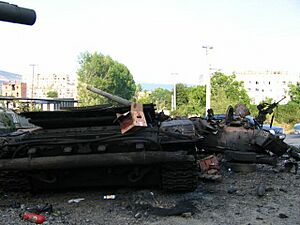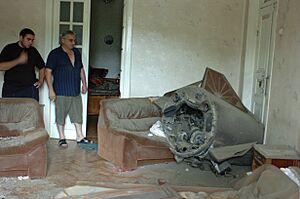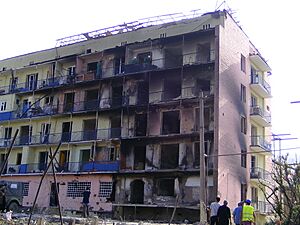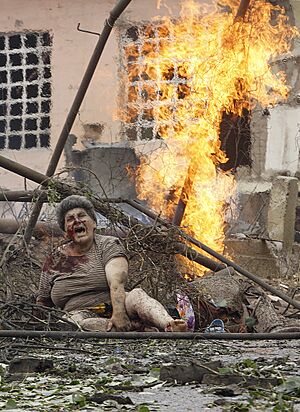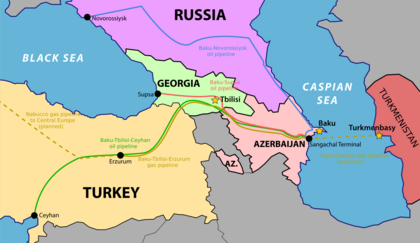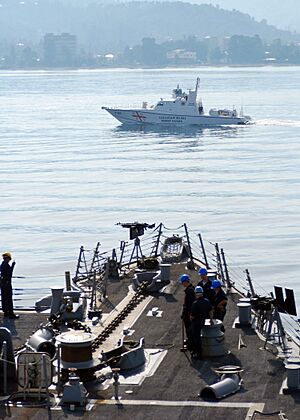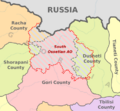Russo-Georgian War facts for kids
Quick facts for kids Russo-Georgian War |
|||||||||
|---|---|---|---|---|---|---|---|---|---|
| Part of the Abkhazia conflict, Georgian–Ossetian conflict, and Post-Soviet conflicts | |||||||||
 Location of Georgia (including Abkhazia and South Ossetia) and Russian North Caucasus |
|||||||||
|
|||||||||
| Belligerents | |||||||||
| Commanders and leaders | |||||||||
|
|
||||||||
| Strength | |||||||||
|
|
||||||||
| Casualties and losses | |||||||||
|
|
||||||||
Civilian casualties:
Refugees:
|
|||||||||
The 2008 Russo-Georgian War was a short but important conflict. It involved Russia and two regions, South Ossetia and Abkhazia, fighting against Georgia. These regions had declared themselves independent with Russia's support. The war happened in August 2008 after a period of tension between Russia and Georgia. Both countries used to be part of the Soviet Union. The fighting took place in the South Caucasus area, which is a very important location. Many people see this war as the first major conflict in Europe in the 21st century.
Contents
Understanding the Conflict: Why the War Happened
The Republic of Georgia became independent in April 1991. This happened after a vote during the time the Soviet Union was breaking apart. However, some parts of Georgia, like South Ossetia and Abkhazia, wanted to break away. They fought wars in the early 1990s. These regions ended up being controlled by groups supported by Russia, but most countries didn't recognize them as independent.
Early Problems and Tensions
In 1992, a group of peacekeepers from Georgia, Russia, and Ossetia was placed in South Ossetia. A similar situation happened in Abkhazia. After Vladimir Putin became president of Russia in 2000, and Georgia had a pro-Western change in power in 2003, relations between Russia and Georgia got worse. By April 2008, things were very tense. This was because NATO said it would consider letting Georgia join its alliance.
How the Fighting Started
On August 1, 2008, forces in South Ossetia, backed by Russia, started firing at Georgian villages. Georgian peacekeepers fired back. These attacks broke a ceasefire agreement from 1992. To stop the attacks, Georgia sent its army into the South Ossetian conflict zone on August 7. They quickly took control of most of Tskhinvali, a main city for the separatists.
Some Russian troops had already entered South Ossetia through the Roki Tunnel before Georgia's military moved in. Russia then claimed Georgia was committing "genocide" and "aggression." On August 8, Russia launched a full-scale invasion of Georgia by land, air, and sea. They called it a "peace enforcement" operation.
Russian and South Ossetian forces fought Georgian forces for several days. Georgian forces eventually pulled back. Russian and Abkhaz forces also attacked the Kodori Gorge, which Georgia controlled. Russian naval forces blocked part of Georgia's Black Sea coast. The Russian air force attacked targets across Georgia. This war was one of the first times that cyber attacks happened at the same time as military action. There was also a lot of information warfare, where both sides tried to control the story.
The President of France, Nicolas Sarkozy, helped negotiate a ceasefire agreement on August 12.
After the Main Fighting
Russian forces temporarily took over Georgian cities like Zugdidi, Senaki, Poti, and Gori. They stayed in these areas even after the ceasefire. Many ethnic Georgian villages in South Ossetia were destroyed. Many Georgians were forced to leave their homes, which is called ethnic cleansing.
Russia recognized Abkhazia and South Ossetia as independent countries on August 26. Because of this, Georgia ended its diplomatic relations with Russia. Russia mostly pulled its troops out of the undisputed parts of Georgia by October 8. The war caused 192,000 people to become displaced, meaning they had to leave their homes. Many returned, but thousands of Georgians remained displaced for years.
In 2021, the European Court of Human Rights ruled that Russia had "direct control" over the separatist regions. They said Russia was responsible for serious human rights abuses there. In 2022, the International Criminal Court issued arrest warrants for three Russian people. This was for war crimes against ethnic Georgians during the conflict.
Key Moments of the War
The Start of Hostilities
On August 1, a bomb exploded near Tskhinvali, hurting five Georgian police officers. Georgian snipers fired back, killing four Ossetians. South Ossetian forces then started heavily shelling Georgian villages. This led to more firing from Georgian peacekeepers.
On August 3, Russia's deputy defense minister met with separatist leaders in Tskhinvali. On the same day, South Ossetian women and children began to be evacuated to Russia. South Ossetian leader Eduard Kokoity said that volunteers from North Ossetia were arriving to help fight Georgia.
On August 7, fighting continued. Georgian forces started moving towards Tskhinvali. Georgian President Saakashvili announced a ceasefire, but the separatists continued to shell Georgian villages. Georgian officials said they had to "restore constitutional order" because of the attacks. Some reports suggest Russian troops had already entered South Ossetia before Georgia's main military response.
Battle for Tskhinvali
On August 7, around 11:35 PM, Georgian artillery fired into South Ossetia. After a short break, Georgian forces began attacking military targets. Georgian troops moved into Tskhinvali early on August 8. They aimed to take key positions and block Russian military movement.
The Russian air force began bombing targets in South Ossetia and Georgia proper. Russia claimed it was defending its peacekeepers and Russian citizens in South Ossetia. Around 4:00 PM, Russian tank columns from the 58th Army entered South Ossetia. They surrounded Tskhinvali and started bombing Georgian positions.
Georgian troops left the center of Tskhinvali that evening. Military experts later said that Russia's large-scale response must have been planned long before August 8. On August 9, Georgian efforts to push back into Tskhinvali were stopped by a strong Russian counterattack.
Bombing and Occupation of Gori
Gori is an important city in central Georgia, not far from Tskhinvali. On August 9, Russia bombed Gori, hitting military areas and civilian buildings. The Georgian government reported that 60 civilians were killed.
Georgian forces left Gori on August 11 to protect the capital, Tbilisi. By late August 11, most people and Georgian troops had left Gori. Russian bombers attacked Gori again on August 12, killing seven people, including Dutch journalist Stan Storimans.
Russian forces captured Gori on August 13. They began destroying Georgian military bases. Reports said Russian soldiers warned Georgian civilians they would not be spared if they didn't surrender. The occupation of Gori lasted until August 22, when Russian troops left and Georgian police returned.
Fighting on the Abkhaz Front
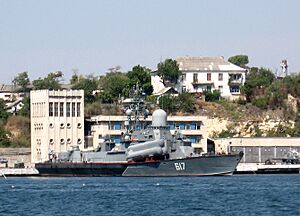
On August 10, Russian and Georgian ships clashed at sea. Russia claimed its fleet sank one Georgian ship. The Russian Black Sea Fleet also blocked the Georgian coast.
Abkhaz forces opened a second front by attacking the Kodori Gorge, which was controlled by Georgia. Abkhaz artillery and aircraft bombed Georgian troops there. On August 12, Abkhaz separatists officially started a military attack on the Kodori Gorge. Abkhaz officials said Georgian forces were driven out.
On August 11, Russian forces advanced into western Georgia from Abkhazia. Russian troops captured police buildings in Zugdidi and a military base in Senaki.
Occupation of Poti
Poti is a very important seaport for Georgia on the Black Sea. It's a key entry point for goods to Georgia and Central Asia. Russian aircraft attacked Poti on August 8, closing the port for two days. Russian ships were positioned near Poti and other Georgian ports.
On August 13, Russian troops sank six Georgian boats in Poti. Even after Russia said it would withdraw, 70 Russian soldiers moved into the seaport on August 19. They took Georgian troops prisoner and seized US military vehicles. The Russian military looted and damaged property in Poti.
Bombing of Tbilisi and Nearby Areas
During the fighting, the Russian Air Force repeatedly attacked Tbilisi and its surrounding areas. On August 8, a military base near Tbilisi was hit by bombs. A Georgian military airstrip in Marneuli was attacked, killing three people.
On August 9, Georgian authorities reported that Russian air attacks targeted the Baku–Tbilisi–Ceyhan oil pipeline, but missed. On August 10, explosions were heard near Tbilisi International Airport, and a military manufacturing plant was attacked. Even after the ceasefire was declared on August 12, Russian planes continued to drop bombs in Georgia.
After the War: What Happened Next
Russian Withdrawal
On August 17, Russian President Medvedev announced that Russian troops would start leaving Georgia the next day. On August 19, the two countries exchanged prisoners. By August 22, Russian forces had left Igoeti, and Georgian police returned to Gori. Russia claimed its withdrawal was complete, but checkpoints remained near Gori and Poti.
On September 8, Russia and France signed another agreement for Russia to pull back from Georgia. Russian forces withdrew from areas bordering Abkhazia and South Ossetia by October 8, 2008. The European Union Monitoring Mission in Georgia (EUMM) then started overseeing these areas.
Russia kept a single station in the border village of Perevi until October 18, 2010, when all Russian forces there withdrew.
Russia Recognizes Abkhazia and South Ossetia

On August 25, 2008, the Russian parliament voted to ask President Medvedev to recognize Abkhazia and South Ossetia as independent countries. On August 26, Medvedev officially recognized them. He said it was the "only possibility to save human lives."
Many countries, including the United States, France, and members of NATO, criticized Russia's decision. They said it violated Georgia's territory and the ceasefire agreement. In response, Georgia ended its diplomatic relations with Russia.
Russia tried to get other countries to recognize Abkhazia and South Ossetia, but most did not.
Russian Military Presence After the War
After the war, Russia greatly increased its military presence in South Ossetia and Abkhazia. Before the war, Russian troops were there as peacekeepers. But after 2008, Russia signed agreements with the new "independent" regions. This allowed Russia to keep its armed forces there.
From 2009, Russia built new military bases in both regions. They also built border guard bases to mark and "protect" the borders of South Ossetia and Abkhazia with Georgia. About 3,500 Russian soldiers and 1,500 FSB personnel are now in each region. Georgia still considers these two regions to be occupied by Russia.
International Monitors
The missions of the Organization for Security and Cooperation in Europe (OSCE) and the United Nations Observer Mission in Georgia (UNOMIG) in Georgia ended in 2009. This happened because Russia refused to support their continuation.
Since October 2008, the European Union Monitoring Mission in Georgia (EUMM) has been monitoring the borders of South Ossetia and Abkhazia. The mission is supposed to work in all of Georgia, but the local authorities in South Ossetia and Abkhazia don't let them in. The EUMM also helps build trust and solve incidents.
Global Impact of the War
The 2008 war was the first time since the fall of the Soviet Union that Russia used its military against an independent country. This showed that Russia was willing to use force to achieve its goals. Some experts believe this war marked a "return of history," meaning major power conflicts were back.
The war also showed weaknesses in Western security groups. They didn't react quickly enough to Russia changing borders by force. It also highlighted differences between Western and Eastern European countries on how to deal with Russia. Ukraine and other former Soviet countries learned that joining NATO might lead to military action from Russia.
The war affected Georgia's chances of joining international groups. Georgia left the Commonwealth of Independent States (CIS) in 2009, blaming it for not preventing the war. The war also made it harder for Georgia to join NATO.
Some experts believe that the way the EU reacted to Russia's actions in Georgia in 2008 might have encouraged Russia to act similarly in Ukraine later. The Russian invasion of Ukraine in 2022 brought back memories of the Russo-Georgian War. Leaders like British Prime Minister Boris Johnson said that the West failed to learn lessons from Russia's actions in Georgia in 2008.
International Reactions to the Conflict
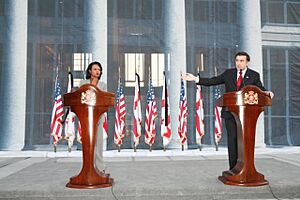
Many Western countries strongly criticized Russia's actions during the war:
- Ukraine – Ukraine was worried about the conflict. Its president, Viktor Yushchenko, suggested that Ukraine might not extend Russia's lease on a naval base. Ukrainians feared Russia might invade Crimea, which happened in 2014, and later a full invasion of Ukraine in 2022.
- Sweden – Swedish Foreign Minister Carl Bildt said Russia's reason for war was like Adolf Hitler's actions. He said no country should invade another just because its citizens live there.
- United Kingdom – British Foreign Secretary David Miliband said he was very upset that Russia expanded the fighting beyond South Ossetia.
- United States – US President George W. Bush said Russia's invasion was "unacceptable in the 21st century." He urged Russia to sign the ceasefire agreement. The US sent humanitarian aid to Georgia.
- Poland – The presidents of Poland, Lithuania, Estonia, Ukraine, and the prime minister of Latvia visited Georgia to show support. They spoke at a large rally in Tbilisi.
- Hungary – Hungarian opposition leader Viktor Orbán compared Russia's actions to the crushing of the Hungarian Revolution of 1956.
France and Germany took a more neutral position, not directly blaming one side:
- European Union – France, which held the EU presidency, announced that the EU and US would send a team to negotiate a ceasefire.
- Germany – German Chancellor Angela Merkel urged an end to the war and expressed concern for people in Georgia.
Some leaders supported Russia's position:
- Italy – Italian Foreign Minister Franco Frattini said Europe should not create an "anti-Russia coalition." He noted that Vladimir Putin and Italian Prime Minister Silvio Berlusconi were close partners.
- Belarus – President of Belarus Alexander Lukashenko said Russia "acted calmly, wisely and beautifully."
The EU Report on the War
In 2008, Georgia asked the EU to investigate who was responsible for the conflict. A report was published in September 2009. It stated that the fighting started with Georgia's military operation against Tskhinvali on the night of August 7-8. However, the report also said that this was the "culminating point" of a long period of rising tensions and incidents. It concluded that it couldn't blame only one side for the conflict.
The report faced criticism from some researchers. They said it left out facts that showed Russia and South Ossetians started the war. Some believed the report was influenced by Russian state information.
NATO's Reaction in the Black Sea
After the Russian invasion, NATO increased its naval presence in the Black Sea. NATO ships visited Georgian ports, bringing humanitarian aid. Russia questioned this, saying the ships might be bringing military supplies. Russia also reminded NATO about limits on how many ships could enter the Black Sea under a 1936 agreement.
Military Forces and Losses
Georgian Military Forces
The Georgian army included several infantry brigades, an artillery brigade, and special forces. About 16,000 Georgian troops were involved. The best Georgian troops were serving in Iraq at the time and couldn't participate in the early fighting. This suggests Georgia did not plan to start the war.
Russian and Allied Military Forces
The Russian forces included a large part of the 58th Army, which is one of Russia's top military units. This army was much larger than Georgia's in terms of soldiers, heavy weapons, and planes. South Ossetian and Abkhaz forces also fought alongside Russia.
Equipment Losses and Costs
After the ceasefire, Russia tried to destroy Georgia's military equipment. Most of Georgia's losses happened after the ceasefire was signed.
- Georgia's Losses:
- Tanks: About 20 tanks were destroyed in fighting. Georgia lost at least 10 tanks in Tskhinvali. After the fighting, Russia seized 65 Georgian tanks, destroying about 20 of them.
- Armored Vehicles: Less than 10 armored vehicles were destroyed in combat. At least 20 more were captured after the fighting.
- Artillery: Two Georgian self-propelled howitzers were destroyed, and two were captured. Many other artillery pieces were left behind or captured.
- Air Defense: Several air defense systems were captured by Russia.
- Firearms: Russia seized 1,728 firearms from a Georgian military base.
- Navy: Georgia lost one boat at sea. Four boats were sunk in Poti.
- Air Force: Only three transport planes and four helicopters were lost. The Georgian air force stopped flying after August 8.
Georgia's Defense Minister said Georgia lost military equipment worth about $250 million. However, Georgian President Saakashvili claimed his country saved 95% of its armed forces.
- Russia's Losses:
- Aircraft: Russia admitted losing three Su-25 attack planes and one Tu-22 long-range bomber. Some reports suggest higher losses for Russia's air force.
- Ground Equipment: Russia is estimated to have lost three tanks, at least 20 armored vehicles, and 32 non-armored vehicles in combat.
- Cost: The five-day war cost Russia an estimated 12.5 billion rubles (about $500 million at the time).
South Ossetian forces lost two BMP-2 armored vehicles.
Images for kids
-
U.S. President George W. Bush and Georgian President Mikheil Saakashvili in Tbilisi, May 2005.
-
Russian President Vladimir Putin at the 2008 Bucharest Summit.
-
Joint press conference by Russian President Dmitry Medvedev and French President Nicolas Sarkozy after negotiations on the peace plan.
-
Sergey Bagapsh (left), Dmitry Medvedev (middle), and Eduard Kokoity (right) shortly after the recognition of Abkhazia and South Ossetia.
-
A Russian Tu-22M3 bomber.
See also
 In Spanish: Guerra ruso-georgiana para niños
In Spanish: Guerra ruso-georgiana para niños



